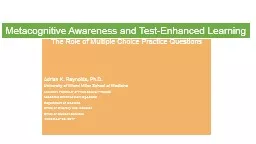

Metacognitive Awareness and TestEnhanced Learning The Role of Multiple Choice Practice Questions Adrian K Reynolds PhD University of Miami Miller School of Medicine Assistant Professor of Professional Practice ID: 769451
Download Presentation The PPT/PDF document "Metacognitive Awareness and Test-Enhance..." is the property of its rightful owner. Permission is granted to download and print the materials on this web site for personal, non-commercial use only, and to display it on your personal computer provided you do not modify the materials and that you retain all copyright notices contained in the materials. By downloading content from our website, you accept the terms of this agreement.
Metacognitive Awareness and Test-Enhanced Learning The Role of Multiple Choice Practice Questions Adrian K. Reynolds, Ph.D. University of Miami Miller School of Medicine Assistant Professor of Professional Practice Academic Enhancement Specialist Department of Medicine Office of Diversity and Inclusion Office of Student Services November 28, 2017
Learning Objectives After active participation in this session, the learner will be able to: Explain the concepts of active learning and self-regulated learning. Use practice questions as test-enhanced learning tools. Use a self-regulated learning microanalytic protocol to increase awareness of metacognitive strategies for answering clinical vignette, multiple choice test questions.
What is active learning? 1,2
What is self-regulated learning? 3,4,5
What is the role of practice questions in test-enhanced learning? Self-testing for learning vs. self-testing for test-taking Recognition vs. retrieval Don’t panic if your answer is incorrect: You now know what you need to learn. Practice questions are the turn signals in your learning GPS.
How do I use practice questions for test-enhanced learning? A 58-year-old man is brought to the emergency department because of weakness of the right arm and face and an inability to speak. He has a history of alcohol use, cigarette smoking, and hypertension. Neurologic examination shows an alert mental status. He is only able to say a few words with great effort, is unable to repeat, but can follow simple commands. He has a decreased right nasolabial fold and decreased movements of his right face, sparing the forehead. He has no right arm movement, but is able to raise his right leg. Occlusion of which of the following blood vessels best explains the findings in this patient? Left anterior cerebral artery Left middle cerebral artery Posterior cerebral artery Posterior inferior cerebellar arteryRight anterior cerebral arteryRight middle cerebral artery(correct answer with explanation)
The Self-Regulated Learning Microanalytic Protocol : Metacognitive Awareness and Test-Enhanced Learning 6
How do I use a self-regulated learning microanalytic protocol ? A 45-year-old man comes to the physician because of progressive difficulty breathing through the left side of his nose. He notices blood stained tissue when he blows his nose, but denies headaches or changes in hearing. He immigrated from China 15 years ago. He has smoked 1 pack of cigarettes per day for the past 16 years. Physical examination shows a mass located in the left posteromedial aspect of the nasopharynx and two enlarged, nontender cervical lymph nodes. Head CT scan confirms a mass in the left nasopharynx with extension into adjacent soft tissue. A biopsy is performed. Histologically, the neoplasm is composed of large anaplastic cells admixed with abundant normal-appearing lymphocytes. The anaplastic cells are positive for cytokeratin and negative for leukocyte common antigen (LCA) on immunohistochemical stain. Which of the following is the most likely cause of this patient's condition? Cigarette smoking Epstein-Barr virus infectionHuman papilloma virus infectionIonizing radiationOverexpression of the bcl-2 gene
References McNamara DS. Strategies to read and learn: Overcoming learning by consumption. Medical Education . 2010;44(4):340–346. Augustin M. How to learn effectively in medical school: Test yourself, learn actively, and repeat in intervals. Yale Journal of Biology and Medicine. 2014;87(2):207–212. Zimmerman BJ. Self-regulated learning and academic achievement: an overview. Educational Psychologist. 1990;25(1):3-17. Zimmerman BJ, Campillo, M. Motivating self-regulated problem solvers. In: Davidson JE, Sternberg, RJ, eds. The nature of problem solving New York: Cambridge University Press 2003; 233-262. Brydges R, Butler D. A reflective analysis of medical education research on self-regulation in learning and practice. Medical Education. 2011;46(1):71–79. Andrews MA, Kelly WF, DeZee KJ. Why does this learner perform poorly on tests? Using self-regulated learning theory to diagnose the problem and implement solutions. Academic Medicine. 2016;20(10):1-4.
Thank you!!